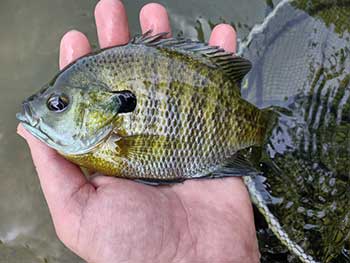 Fishing is a great way to spend time outside and create memories with the people you care about. But what happens if the water is muddy, the weather is cold or raining, or you want to try a new location? The tips below will help lead you to fishing success throughout the year in a variety of water and safe weather conditions. For more information on what equipment to bring, including a breakdown of the different types of lures, check out our fishing equipment tips.
Fishing is a great way to spend time outside and create memories with the people you care about. But what happens if the water is muddy, the weather is cold or raining, or you want to try a new location? The tips below will help lead you to fishing success throughout the year in a variety of water and safe weather conditions. For more information on what equipment to bring, including a breakdown of the different types of lures, check out our fishing equipment tips.
- What to cast based on water clarity
Clear (2’+ visibility)
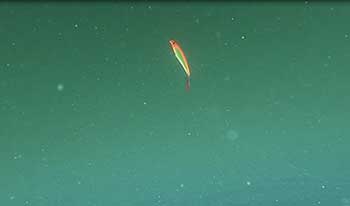
- Try silver and flashy lures to reflect light, or naturally colored lures that look like prey (fish food).
- Try spoons, spinners, jerkbaits, lipless crankbaits, spinner baits with willow (slender) blades, and soft plastics.
Stained (3-6” visibility)
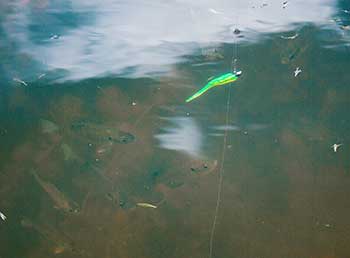
- Go bright so fish can see what you are reeling in.
- Try chartreuse (yellow-green colored) soft plastics, bright lipless crankbaits, and lures with gold or copper blades.
Muddy (1-2” visibility)
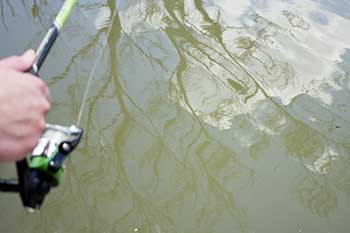
- Use dark colors and vibration to get the fish’s attention.
- Try bladed swim jigs, rattling (or wobbling) crankbaits, spinner baits with Colorado (round) blades, and soft plastic stickbaits to bounce off the bottom or jerk on the surface.
- What is biting when?
March and April
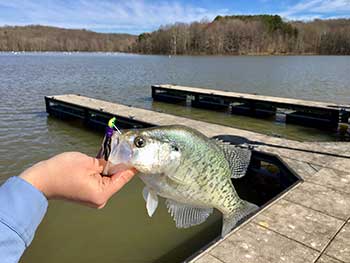
Best time to cast a line
- If sunny, fish late afternoon or early evening to allow sunshine to warm the water, especially shallow waters. Warm waters speed up fish metabolism, making them more active and more likely to bite. Silver and naturally colored lures work best depending on water condition.
- If cloudy, fish swim around more than on sunny days looking for prey/food. Even so, try fishing later in the day to allow the day to warm shallow waters. Gold, brightly colored, and fluorescent lures work best depending on water condition.
- If windy, cast at the wind-blown shoreline because wind will move warm surface water and food into the shallows. Try heavier lures if the wind is making it difficult to cast light lures. Watch out for snags like tree limbs.
- In all conditions, retrieve (reel in) your lure slowly. Fish are not very active or aggressive in cold water.
Fishing opportunities
- Crappie: Chilly shallows are beginning to warm thanks to higher temperatures and more daylight hours. Take advantage of the warmer weather by targeting crappie as they move into shallower water. Use crappie jigs or live bait, such as minnows, and focus your efforts around areas with sunken logs, standing timber, brush piles, weedy edges, or docks. Find great locations on our Where to Fish Map or our crappie fishing website.
- Walleye and sauger: Find walleye and sauger upstream rivers and below dams. Numbers will continue to build until spawning in late March and early April.
- Leadhead jigs with white or chartreuse (yellow-green color) soft plastics are popular baits; be sure to bring plenty, as the rocky bottom will claim its share. Find great walleye fishing locations and fishing tips on our walleye fishing website.
- Indiana’s portion of the Ohio River provides abundant angling opportunities, especially for sauger. During early spring in March and April, adult sauger run upstream to spawn, congregating below locks and dams. Vertical jigging and slow retrieval of crankbaits, soft plastics, and live bait are sure-fire ways to have a good day on the water.
- Muskie: Fish for muskie in shallows, especially near vegetation.
- Largemouth bass: Fish for bass on shallow flats and under nearshore cover.
- Lake Michigan:
- Throughout March and April, large numbers of steelhead trout swim by the pier heads on their upstream migration. Steelhead can be caught using spawn bags (trout or salmon eggs in mesh bags), jigs with waxworms, nightcrawlers, or lures like spinners. If you’re fishing using live bait, make sure to dangle offerings near the bottom and follow all hook restrictions.
- Ample shoreline fishing opportunities become available as ice leaves Lake Michigan, revealing whitefish, steelhead trout, Coho salmon, and brown trout eager to bite. Find good locations on our Where to Fish Map.
May
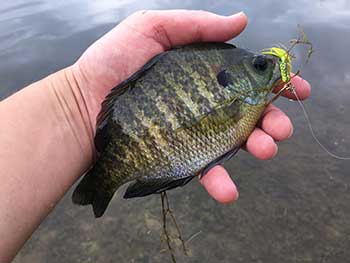
Best time to cast a line
In early May, wait until late afternoon or evening to go fishing. This allows the daytime heat to warm the waters and get sluggish fish more active and willing to bite. Later in May, after a stretch of warm sunny days, the best times to fish are early morning, late afternoon, and even nighttime, especially for bass.
Fishing opportunities
- Crappie, bluegill, and redear sunfish: Crappie have already begun moving into shallower waters to deposit eggs (spawn). Once the water temperature reaches 65 degrees, bluegill and redear sunfish will also spawn and feed in the shallows while defending their nests. Target weedy edges, sunken logs, standing timber, brush piles, and docks for these tasty fish. Chartreuse (yellow-green color) or white curly-tailed soft plastic grubs and inline spinners are great lures for panfish. These fish also have a hard time resisting a red worm or bee moth larvae on a size 8 hook.
- Largemouth bass: Target largemouth bass near their spawning beds in shallow areas as water temperatures near 65 degrees. Use soft plastic worms (with or without a bullet-shaped weight) and soft plastic stick baits (see photo) to entice these fighting fish. Cast a spinner bait if bass are active near the surface. Find good locations on our Where to Fish Map.
Summer
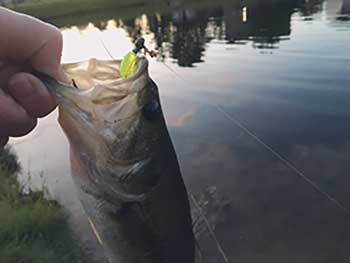
Best time to cast a line
Fish early morning, late afternoon, and even nighttime, especially for largemouth bass.
Fishing opportunities
- Bluegill and redear sunfish: Fish for bluegill and redear along the shore with live bait or small lures. Learn more about sunfish fishing.
- Largemouth bass: Start by fishing in shallow water. If largemouth have moved off their spawning beds, look for cover like overhanging branches, boat docks, and vegetation. Most lures will work when the water is warm. Learn more about largemouth bass fishing.
- Lake Michigan: Once summer water temperatures reach 60–66 degrees, shoreline fishing takes off along Lake Michigan. Summer waters often bring yellow perch, bass, walleye, catfish, and freshwater drum close to shore.
Fall
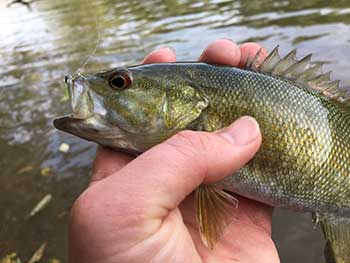
Best time to cast a line
Early fall, fish in the morning and evening. Mid to late fall, fish in the afternoon or early evening when the water is at its warmest and fish are the most active.
Fishing opportunities
- Predator fish: Muskie, striped bass and hybrid striped bass, rock bass, smallmouth bass, and largemouth bass are chasing baitfish in the shallows, so cast lures that look like minnows and shad. You can also slip on some old sneakers and wade streams for smallmouth bass and rock bass.
- Crappie: Crappie are searching for prey hiding near sunken logs, standing timber, brush piles, or docks. Use flip jigs or live bait to attract their attention.
- Trout and salmon: Try casting flies, spinners, and spoons for trout and salmon once they return to Lake Michigan tributaries.
- Bluegill and catfish: Bluegill and catfish continue to bite in waters across the state. They are focused on consuming calories before the winter cold approaches. Cast live bait or lures to catch active bluegill. Sink smelly bait to the bottom for catfish.
Fishing in the rain
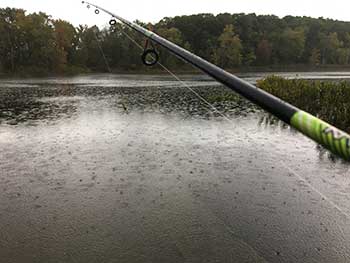
Fishing in the rain can be a great time to get a bite. No sunshine is no problem as low light often spurs fish activity. A cold front will get fish moving before a storm hits and a warm front will warm surface temperatures, energizing fish to feed before, during, and after the weather rolls in. Rain can also wash food (like insects) into the water, which will trigger feeding. Plus, you are much less likely to spook fish with raindrops hitting the surface. Wear a hat, put on your rain jacket early, and keep a dry set of clothes nearby. Don’t let a few raindrops stop you from getting a line wet at a lake or stream near you.Fishing in the cold
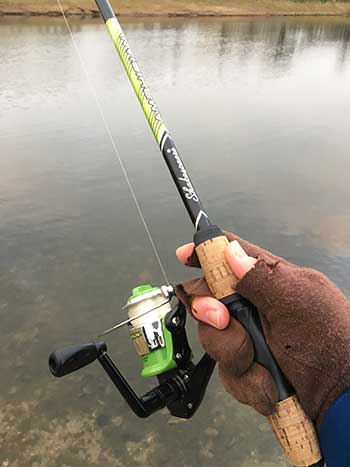 The air is cold, and winter is near, but open water fishing season isn’t quite over. Fish move slowly in cold water, but fish will bite because they still need to eat. An occasional twitch of a jerkbait or a sinking, fluttering crankbait or spoon can imitate dying baitfish and trigger strikes, but if those lures are not working, cast smaller lures with light line and retrieve slowly. Try small jigs with hair, feathers, tiny spider-like legs, or a soft plastic tail. You can also try live bait on small hooks under small bobbers.
The air is cold, and winter is near, but open water fishing season isn’t quite over. Fish move slowly in cold water, but fish will bite because they still need to eat. An occasional twitch of a jerkbait or a sinking, fluttering crankbait or spoon can imitate dying baitfish and trigger strikes, but if those lures are not working, cast smaller lures with light line and retrieve slowly. Try small jigs with hair, feathers, tiny spider-like legs, or a soft plastic tail. You can also try live bait on small hooks under small bobbers.Mid to late afternoon is the best time to fish in winter. Fishing before a cold front is a good time for catching fish, and if a warm front happens to roll in, get to the water and wet a line before, during, and after. Dress warm, keep toes and fingers dry, and be patient.
If you plan to stay longer than a quick fishing stop, bring a snack packed with protein and fiber to keep you energized. Bring a thermos with hot coffee, hot cocoa, or soup.
- River Fishing made simple
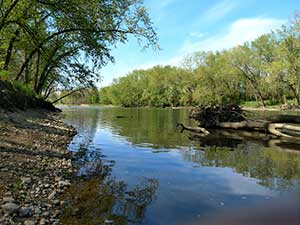
Best times to fish
Late summer and fall are good times to fish rivers, especially if you plan to wade. Water levels are lower and not as fast-moving.
Gear
- Light shorts (or swimsuit) – dress in clothes that can get wet and will dry quickly; be sure to wear waders in cold water.
- Old sneakers – wear shoes that can get wet and dirty, but still protect your feet and toes.
- Needle-nose pliers – these are useful to cut line to release fish. You can also use them to smash down barbs on hooks for easier release.
- Other helpful items – extra clothes/shoes, old beach towel, backpack or fanny pack, water bottle, snacks, basic first aid kit, bug spray, sunscreen, and sealable bag for phone and other valuables.
Rig
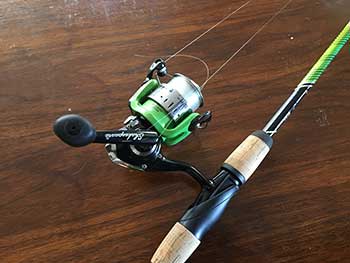
A short, basic, inexpensive fishing pole with light line is ideal for casting small lures around trees, rocks, and bridges. Try a 5’6” spinning combo with 6 lb. line to start.
Lure
- 1/8 oz. yellow or green inline spinners are great options for multiple species.
- You can also try 1/8 oz. green beetle spins and 1/16 oz jig heads with chartreuse curly tailed grubs.
Where to cast
- Upstream: since fish often face upstream to wait for food to flow their way, cast upstream, allowing the current to drift your bait or lure downstream
- Shade: below overhanging, shoreline vegetation, among expose roots along the bank, and bridges
- Slower current: eddies and behind large rocks or rock piles
- Deeper areas: pools and outside bends
- Merging currents: fish below where two rivers meet and where small streams connect with larger rivers
- View more river fishing tips
